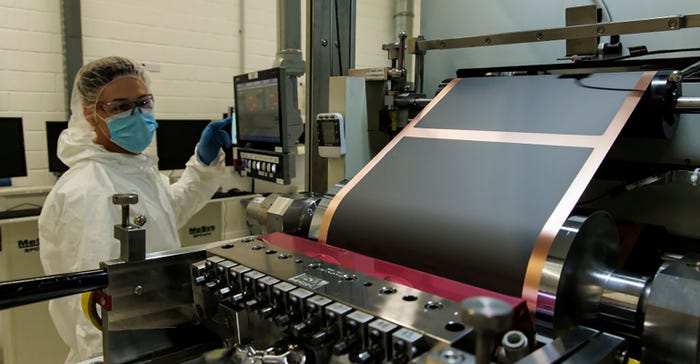Battery Manufacturing Basics: What Everyone Should Know
Producing batteries requires unique tools and skills; here’s an overview of what goes on inside the factory walls.

Coating machine that produces the anode of battery test pouches.Credit: Morris MacMatzen/ Stringer/ Getty Images News via Getty Images
Followers and investors in the battery industry are constantly receiving news: Updates about supply-chain issues, material acquisition challenges, the jostling of the industry’s leaders for advantage, and the impacts of government decisions around the world. It can be a lot. (You’re welcome.)
To keep all of this information in context, it’s important to have an understanding of what happens where all of these issues come together, within the walls of battery manufacturing facilities.
Manufacturer considerations
When battery manufacturers are planning a new production facility, they consider a number of factors to ensure a successful and efficient operation. Here are five key issues they address:
Site Selection and Infrastructure: Choosing the right location for a new production facility is crucial. Manufacturers need to assess factors such as proximity to raw material sources, transportation infrastructure, and access to skilled labor. Additionally, evaluating the availability of utilities like water and electricity is essential for the efficient operation of the facility.
Technology and Equipment Investment: Selecting the appropriate manufacturing technology and equipment is a critical decision. Manufacturers should invest in state-of-the-art production machinery and automation systems to enhance efficiency, reduce production costs, and maintain high-quality standards. Keeping abreast of the latest advancements in battery manufacturing technology is essential for staying competitive.
Environmental Compliance and Sustainability: Battery manufacturers must prioritize environmental considerations and adhere to regulatory standards. This includes implementing sustainable practices, minimizing waste, and adopting eco-friendly manufacturing processes. Compliance with environmental regulations is not only a legal requirement but also contributes to positive brand image and market acceptance.
Workforce Training and Safety: A well-trained and safety-conscious workforce is essential for smooth operations. Battery manufacturing involves handling potentially hazardous materials, so ensuring proper training in safety protocols is crucial. Additionally, creating a positive and safe working environment promotes employee well-being and can contribute to increased productivity.
Scalability and Flexibility: Planning for scalability is vital, especially in a rapidly evolving industry. Manufacturers should design their facilities with the capacity to scale up production to meet increasing demand. Flexibility in production processes allows for easier adaptation to changes in technology or market demands, providing a competitive edge and long-term sustainability.
Diagramming the processes
To better understand how all these myriad factors come together, the following are seven diagrams that illustrate the basic processes. These slides are courtesy of Volta Foundation’s 2023 Battery Report 2023, an incredibly useful 299-page compendium of industry knowledge that, from March 26, is available as a free PDF download, here.
(Special thanks to Volta Foundation for making their work available. Slides are shared to Battery Technology under Creative Commons CC by 4.0 Deed license.)
Let’s take a look:
About the Author(s)
You May Also Like





